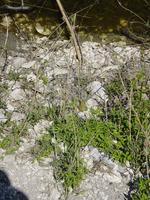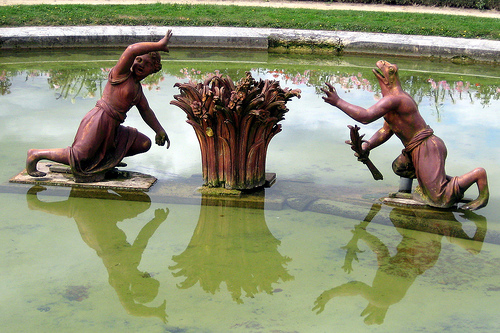 |
|
|
|
Letoön Letoön was the sacred cult center of Lycia, its most important sanctuary, and was dedicated to the three national deities of Lycia - Leto and her twin children Apollo and Artemis. Leto was also worshiped as a family deity and as the guardian of the tomb. Letoön lies less than 10 km to the south of Xanthos on a fertile plain. Xanthos and Letoon are often seen as a "double-site", since the two were closely linked and Letoon was administered by Xanthos. Xanthos-Letoon is one of the most remarkable archaeological sites in Turkey. For this reason, it has been registered in the UNESCO World Heritage Sites list. Letoon has been under excavation since the 1950's and since 1962 by the French Archaeological Mission, in conjunction with the excavatiobeing carried out at Xanthos. Excavation goes on today - the team has done some excellent work and in recent years has begun to restore the Temple of Leto ...... ........
|
|
|
|
temple of Artemis |
| Letoön - the temples of Leto , Artemis and Apollo - a small Byzantine church and a theatre
|
||||||||||||||||||||||||||||||||||||||||||
| |||||||||||||||||||||||||||||||||||
|
|||||||||||||||||||||||||||||||||||||
Leto with Apollo and Artemis In Greek mythology Lētō' (Greek: Λητώ, Lato in Dorian Greek, the "hidden one") is known to be a daughter of the Titans Coeus and Phoebe, and in the Olympian scheme of things, Zeus is the father of her twins, Apollo and Artemis.
Still, Leto is scarcely to be conceived apart from being pregnant and
finding a suitable place to be delivered of Apollo, the second of her
twins. This is her one active mythic role: once Apollo and Artemis are
grown, Leto withdraws, to remain a dim, benevolent matronly figure upon
Olympus, dark and mild, her part already played. In Crete, at Dreros, Marinatos
uncovered an 8th-century post-Minoan hearth house temple in which there
were unique hammered brass figures of Apollo, Artemis and Leto. Walter
Burkert notes (in Greek Religion) that in Phaistos she appears in
connection with an initiation cult. In Roman mythology her equivalent, as mother of Apollo and Diana, is Latona. Leto
was the principal goddess of Anatolian Lycia. Her sanctuary, the Letoon
near Xanthos, united the Lycian confederacy of city-states. The people
of Cos also claimed Leto as their own. A measure of what a primal goddess Leto was can be recognized in her Titan father, whose name "Coeus"
links him to the sphere of heaven from pole to pole, and her mother
"Phoebe," who is precisely the "pure" and "purifying" epithet of the
full moon. When Hera,
the most conservative of goddesses — for she had the most to lose in
changes to the order of nature — discovered that Leto was pregnant and
that Zeus was the father, she realized that the offspring would cement
the new order. She was powerless to stop the flow of events, but she
banned Leto from giving birth on "terra firma", on the mainland, or any
island at sea, or any place under the sun (Hyginus, Fabulae, 140). Some
mythographers hinted that Leto came down from the land of the
Hyperboreans in the guise of a she-wolf, or that she sought out the
"wolf-country" of Lycia for her denning. But most accounts agree that
she found the barren floating island of Delos,
which was neither mainland nor a real island, and gave birth there,
promising the island wealth from the worshippers who would flock to the
obscure birthplace of the splendid god who was to come. The island was
surrounded by swans. As a gesture of gratitude, Delos was secured with
four pillars and later became sacred to Apollo. It
is remarkable that Leto brought forth Artemis, the elder twin, without
struggle or pain, as if she were merely revealing another manifestation
of her self. For Apollo, Leto labored for nine nights and nine days,
according to the Homeric Hymn to Delian Apollo in the presence of all
the first among the deathless goddesses as witnesses: Dione, Rhea,
Ichnaea and Themis and the sea-goddess "loud-moaning" Amphitrite. Only Hera kept apart, and perhaps she kidnapped Eileithyia
or Ilithyia, the goddess of childbirth, to prevent Leto from going into
labor, but Artemis was born first and then assisted with the birth of
Apollo. Another version states that Artemis was born one day before
Apollo, on the island of Ortygia (who is probably an ancient name of
Delos), and that she helped Leto cross the sea to Delos the next day to
give birth to Apollo. Leto
was threatened and assailed in her wanderings by chthonic monsters of
the ancient earth and old ways, and these became the enemies of Apollo
and Artemis. One was the Titan Tityos, a phallic being who grew so vast
that he split his mother's womb and had to be carried to term by Gaia
herself. He attempted to waylay Leto near Delphi, but was laid low by
the arrows or Apollo— or possibly Artemis, as another myth-teller
recalled. Another ancient earth creature that had to be overcome was the dragon Pytho or Python which lived in a cleft of the mother-rock beneath Delphi, beside the Castalian Spring. Apollo slew it but had to do penance and be cleansed afterwards, since Python was a child of Gaia. Sometimes the slaying was said to be because Python had attempted to rape Leto while pregnant with Apollo and Artemis, but one way or another, it was necessary that the ancient oracle pass to the protection of the new god. ...... http://www.mlahanas.de/Greeks/Mythology/Leto.html
|
|
Leto wiith her infants, Apollo and Artemis. From a Vase in the British Museum., 6th century BC
|
||
|
Leto (Latona) and the Birth of Apollo and Artemis on Delos, Diana Scultori |
||
|
|
|
 Mother Earth Leto, is shown sitting on the rocks with Apollo on her right side. The bull and the sheep shown underneath are symbols of flock and herd, which Apollo was also in charge of as duties of a God patron, besides music, prophesie, art, and medicine. http://monalogue.org/content_MonaIdentity.html
|
fountain of Leto at Versailles |
| The east-west axis, comprised of la Fontaine de Latone (Fountain of Latona) and the les bassins des lézards (lizard fountains), was designed by Le Nôtre and constructed between 1663 and 1666, at the cost of considerable excavation work. Balthazar and Gaspard Marcy carved the marble figure of Latona holding her children, Apollo and Diana for the centerpiece of the Fountain of Latona, from 1668 to 1670. The fountain was altered between 1687 and 1689 by Jules-Hardoin Mansar, who gave it its current pyramidal form. The statue of Latona, looking towards the château was rotated 180 derees to face the grand perspective of L'Allée Royale (The Royal Avenue). The fountain depicts Latona (Lētṓ in Greek), the daughter of titans Coeus and Phoebe, holding her children, Apollo and Diana (or Artemis), imploring their father Jupiter (or Zeus) to avenege the ridcule of the Lycian peasants. Juno (or Hera), Jupiter's wife, jealous of Latona for bearing his children, realizing that the offspring would cement a new order, banned her from giving birth on "terra firma"--the mainland, any island at sea, or any place under the sun. She found the island of Delos, which was neither mainland nor a real island, and gave birth there. According to Ovid's Metamorphoses, when Leto was wandering the earth after giving birth, she attempted to drink water and bathe from a pure spring in the province Lycia. The peasants protested by stirring the mud at the bottom of the pond, and driving her out with insults. Enraged, Latona, cried out to Jupiter, who turned them into frogs. The metamorphosis of the peasants is depicted on the bottom three tiers--the first with semi-metamorphosed peasants and frogs, and the 2nd and 3rd with fully-metamorphosed frogs. |








































































